
Live long and prosper: Lessons learned in an ever-evolving 400-gallon Texas marine system
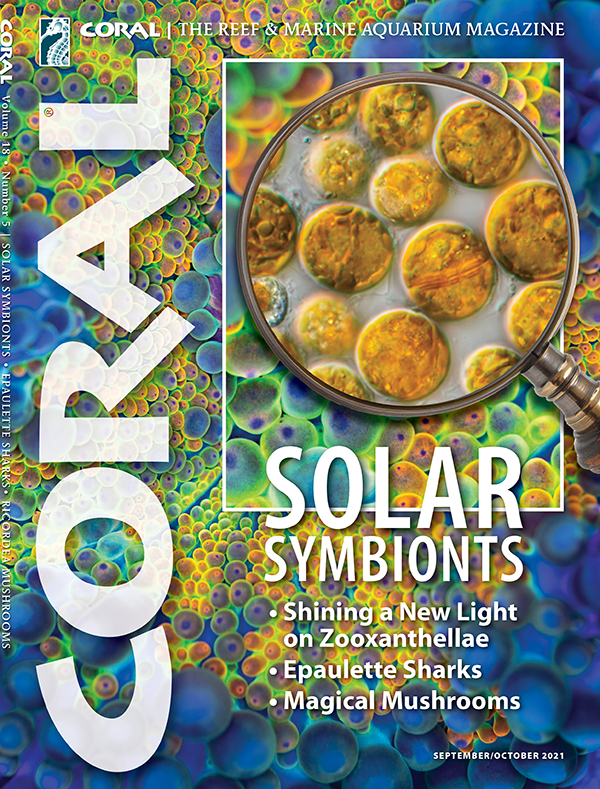
An excerpt from the September/October 2021 issue of CORAL Magazine, by MATT PEDERSEN with MARC LEVENSON. Images by MICHAEL VARGAS
The banana-chomping Naso Tang affectionately known as Spock—“due to her Vulcan eyebrows”—now serves as the mascot of one of the better-known home reef systems in the marine aquarium world. Spock herself has already had a prosperous and even pampered life, having been in the care of a talented Texas aquarist since she was purchased as a small, wild-caught specimen some 17 years ago. (Giving the young Naso literatus a male name seemed logical at the time, and the name stuck even when “he” matured into a “she.”)
Spock’s caretaker is the sci-fi-loving aquarist Marc “Melev” Levenson of Fort Worth, Texas, and the man behind Melev’s Reef, which started out offering customized RO/DI systems and customer acrylic fabrication for reefkeepers, and has now grown into a multi-faceted online retailer offering a wide array of aquarium equipment and supplies. He is also the virtual mentor to tens of thousands of aquarists via his Melev’s Reef YouTube channel, which today boasts nearly 65,000 subscribers who have watched the trials, tribulations, and successes of Marc’s 400-gallon (1,514-L) reef aquarium and a linked 60-gallon (227-L) “Anemone Cube” over the past decade.
LOOKING BACK
Marc credits his father with inspiring his passion for the ocean. “My dad worked in advertising,” he recalls, “and when I went on business calls with him, I was told I had to sit and be quiet. During one visit, sitting on a couch in a reception area, the lady behind the desk said to me, ‘You are so cute, how would you like to go to Tahiti?’ It was a bit of a set-up; my dad had already made the arrangements and soon we flew to Tahiti and took a boat to Mo’orea. I spent the entire week snorkeling in the lagoon. It was amazing, filled with endless varieties of fish and invertebrates. I kept looking at all the tourists sipping drinks at the bar, and I remember thinking, ‘Don’t you realize what’s out there in the water?!’ I took a one-liter bottle, cut off the top, grabbed some sand and hermit crabs, and started taking it around, showing it to anyone who’d look.”
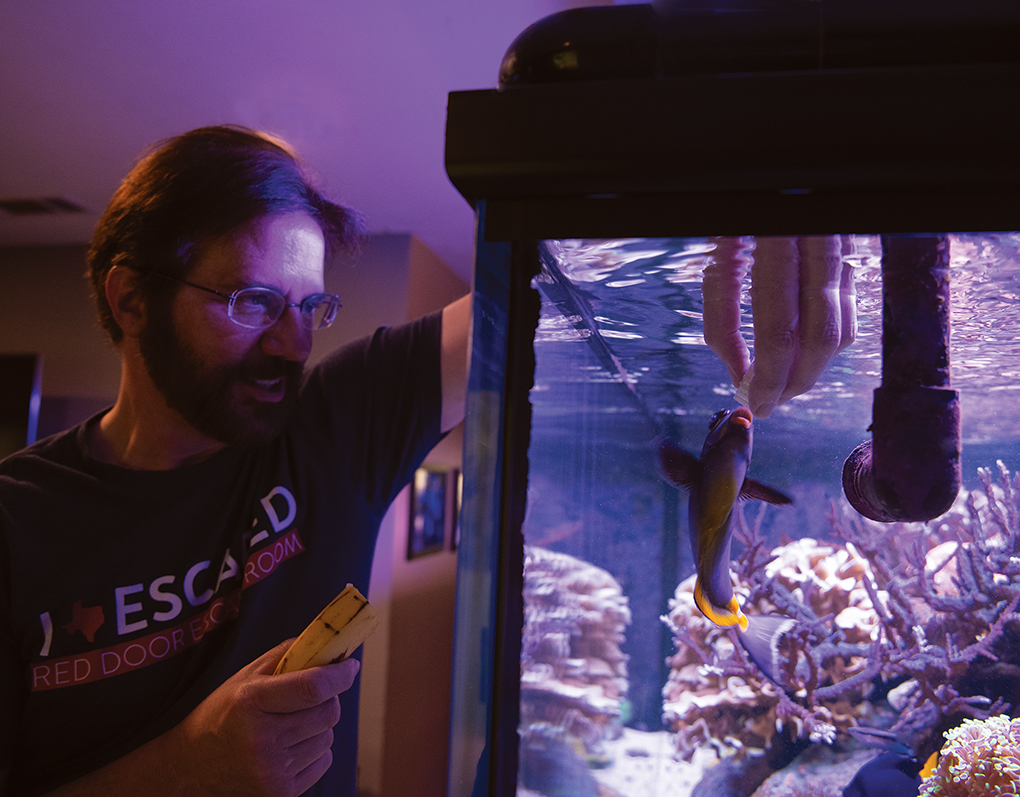
That was a different time in the marine aquarium world. “My dad would come back with coral from Tahiti that he would boil, bake in the sun to turn them white, and put them in his aquarium.” During a recent visit to his parents’ home, Marc noted that those coral skeletons were still on hand, displayed as home décor.
When Levenson was a young boy, his father kept a saltwater “predator tank,” and it was Marc’s job to keep the lionfish away from his father as he cleaned the algae from the glass or worked on the canister filter. At 11 years of age, Marc was permitted to keep his own, a small 20-gallon (74-L) aquarium, and he went straight to saltwater. “With us, the freshwater fish were only food for the saltwater fish,” Marc quips.
With such a small aquarium, the wisdom of the day suggested he could only have one or two fish, which didn’t sit well with him. “When the guy at the aquarium shop said there wasn’t any limit to the number of invertebrates I could put in tank, I got excited. My aquarium was loaded with shrimps, crabs, featherdusters…but one day everything was dead, and when I got home from school that day, the tank and everything in it was gone. That was 1976.”
Marc grew up and got married, became what he calls a professional stripper (of VCT tile floors), and lived a life without aquariums. He had a son and was running his flooring business, and then life threw him a fateful curveball. “I got back into the hobby the day I got divorced,” says Marc. “I walked out of the courtroom with the divorce papers in my hand, went straight to the fish store, and bought myself an aquarium.”
His interest in marine aquariums became all-consuming. “My dad never had the passion for this hobby that I did. He had some fish and some anemones, but I took it to a whole new level. I credit it all to going to MACNA [the annual Marine Aquarium Conference of North America]. MACNA was (and is) reefkeeping college for me. Three days, 21 classes, and I’d come back with a wealth of knowledge, invigorated, and I’d pass it along to other reef aquarists.”
As Marc’s immersion in the marine aquarium hobby and industry grew, so did his tank sizes. He progressed from a 29-gallon reef to a 55-gallon, then made a big leap to a 280-gallon aquarium in 2004. After six years in operation, the well-established large tank sprung a leak in July of 2010. “All the livestock went into Rubbermaid tubs and an insane tangle of filtration and wires,” says Marc. “It took eight months to rebuild the entire fishroom, as well as planning and obtaining the replacement aquarium.”

DISASTER AFTER MIDNIGHT
His current 400-gallon reef was the result of that long process. It fit the space, and Levenson looked at the loss of the 280-gallon tank simply as another opportunity. The aquarium was made to order and features an ultra-clear Starphire front viewing panel. It was up and running by February of 2011. Just 13 months later, in March of 2012, the new aquarium started leaking. “It was 1 AM, and I heard the sound of running water. I went into the fishroom, lit only by the low glow of tiny LED indicator lights, and walked right through a stream of gushing water. It was missing my power center by only inches, with the water flowing down into the French drain. Who was I going to call at 1 AM?! I grabbed a 100-gallon trough and a couple 55-gallon drums, and once again I was emptying livestock from my tank.”

It would be another 18 months before the replacement aquarium was finally delivered to Levenson’s home, this time with Starphire glass on all the viewing panes. The aquarium was put into service in November of 2013. As a teaching tool, the system mostly follows mainstream best practices for a tropical reef aquarium, but one aspect of Marc’s tank design merits special mention.
“Something that makes my reef tank different from almost all the others is an acrylic support system underneath the rockwork. It is a series of different lengths and thicknesses of acrylic dowels, glued to a base plate of acrylic. Each rock has three points of contact, like a tripod, and to this day they are all on those pedestals. It took 15 hours to build it, and I hated every minute of it, but if all the sand were sucked out of the tank the rocks wouldn’t move an inch. Now, anytime I work on the reef I don’t have to worry about anything moving or shifting.”
In 2017 Marc invited fellow reefkeeper Duane Oestreich to rework the reef, which had become overgrown, with corals breaking the surface and shading out everything underneath. “Duane loves to take a giant colony, break it down to the size of a fist, and replant it. At that point in my reefkeeping hobby, I still had the mindset that ‘every polyp matters,’ which made it difficult to watch Duane work! He would take a coral into the fishroom to get out of my sight and then snap it in half so it would fit into the cooler while we worked.”

MY REEF LIVES—IN SPITE OF ME
While Marc is constantly experimenting and using the system as a teaching tool, it has managed to thrive and mature into an impressive display of stony corals, gorgonians and large anemones, with a healthy fish population. “No matter what I’ve ever done, the reef just keeps living. I think the reason the tank does so well is because of the equipment I’ve chosen to use. The gear is important. It doesn’t have to be the best of the best, but it has to be good quality so you don’t have to fix it, correct it, adjust it, glue it back together…I’ve had the same calcium reactor since 2004. The original metal halide fixtures were still running well beyond a decade. If you buy good gear, it will last you a long time if you maintain it, which means taking it down and cleaning it.
“I’m always thinking logistics, too, which means thinking ahead. I bought brand-new Vortech circulation pumps in 2010, and all three were still working after a decade. But this year I just bought new ones to replace them because they were 10 years old and had been running constantly.” After a decade of service, the odds of a failure are rising, even for the best of equipment. “I’d rather have something on the tank that’s somewhat new if I’m traveling,” Marc concludes.

Levenson openly admits to making some big mistakes over the years. A certain amount of patience plays into his success when dealing with problems that would shake most aquarists to the core. “At one point I stopped testing alkalinity, and it slowly rose to 22 dKH without me knowing it. The reef didn’t even care. The SPS were all polyped-out, the Hammer Corals were open! It took me four months to bring the alkalinity back down to 9.5 dkH again. You can’t change things fast. Even with high nitrates in the system, my corals were growing and thriving, and people were asking for frags of them. I let the nitrates get away from me, but the reef survived.”
“When I had Acropora-eating Flatworms, I didn’t kill my tank trying to deal with them. There is this suggestion that you should remove all your Acros from the system and remove every last bit of living Acro tissue from the tank [the goal being to starve out any flatworms still present in the tank]. Then, for the next two or three months, you keep all your Acropora corals in a separate tank and subject them to weekly baths in coral dips. Every story seems to end up the same way…aquarists lose 80–90% of their coral.” Marc says he borrowed an idea from an aquarist with an even bigger system.
“I had watched Joe Yaiullo going into his 20,000-gallon reef, and he was just in there spraying a jet of water. The flatworms would peel off the corals, and the fish would come eat them. So, I just took a turkey baster filled with RO water and puffed that onto my affected Acropora, and the anthias would come over and eat the flatworms. Eventually I just used a hand-held MaxiJet powerhead, and it performed as well. Sure, it took time, but I just thought that all the stress of removing and trying to treat the corals was far worse than this approach.
“The worst mistake with my tank, after all these years, was turning off all the pumps to feed my Sun Corals (Tubastrea sp.). I was already pretty tired, and I wound up never feeding the corals and just going to bed. The next morning a fellow aquarist came over and asked, ‘Why are all the fish on the sand?’ By neglecting to turn my pumps back on, I killed half my fish that night, and I lost some difficult to keep fish. But I learned from it; I’ve never made that mistake twice.”

RESILIENCY
Having gone through two leaking aquariums and having had to keep rescued corals and fish living in buckets for long periods, how has Levenson managed to persist?
“I think there’s an underlying stubbornness that makes me press forward instead of walking away,” he says. “When there’s a problem, I’m always working my way through the solution to get back to where something was before.”
Most recently, Levenson was faced with downright calamity and catastrophe. Immediately after the sudden unexpected death of his partner, fellow aquarist Caitlin Lee who passed away on February 13, 2021, after suffering a seizure, Texas was hit by the brutal February 14 ice storms that severely impacted life in the state for days, and in some cases weeks.
“When that big ice storm hit, and everything I had as a backup failed, there was nothing left.” It turns out that Marc’s generator was suffering mechanical problems, and after a repair, it lasted a few more hours, then suddenly “blew up.” In the middle of the night, he posted an online plea for help, seeking a generator. The nearest ones were hours away. “My friend Jessi [Jessica Pickering] called me from Hawaii and asked what I was going to do. I said, ‘I guess I’m going to watch my tank die, too.’”
Many aquarists would have understandably given up, but a strong social support network and innate stubbornness saw Marc through this incredibly challenging time in his life. Through that network of friends, a brand-new, in-the-box generator was located just two miles from Levenson’s home, but even that short trip took over 30 minutes due to the snow and ice that blanketed Fort Worth.
“It took me two hours to build the generator with only a Coleman lantern in my icy garage, but without that generator I wouldn’t have made it,” Marc recalls. “I kept the system running on that generator until power was restored. The tank had five heaters in it, and the house dropped as low as 58° F (14° C), but the tank never dipped below 76° F (24° C). I kept the water flow and the skimmer running, but obviously I went without the lights during this time period.”
After passing through the darkest of hours, Levenson might have been expected to take a break and take time to recover. Instead, he and his friend Duane Oestreich undertook a second aquascaping tear-down and rebuild of the 400-gallon tank, after the photos for this article were captured by Michael Vargas in June, 2021.
Marc says that this second major overhaul of the aquarium was about lowering nitrates and rethinking the shape of the aquascape. “I wanted to lower the aquascape, as there was a large coral bommie that effectively blocked most of the corals when viewed from the viewing end of the aquarium. I also had to deal with the sandbed and an area I call the ‘Coral Graveyard,’ which, ironically, was actually full of small, living pieces of coral that had been placed there, out of the way in back.” Looking down on these colonies, it is clear that they had taken over the space, even growing up the back wall of the tank.
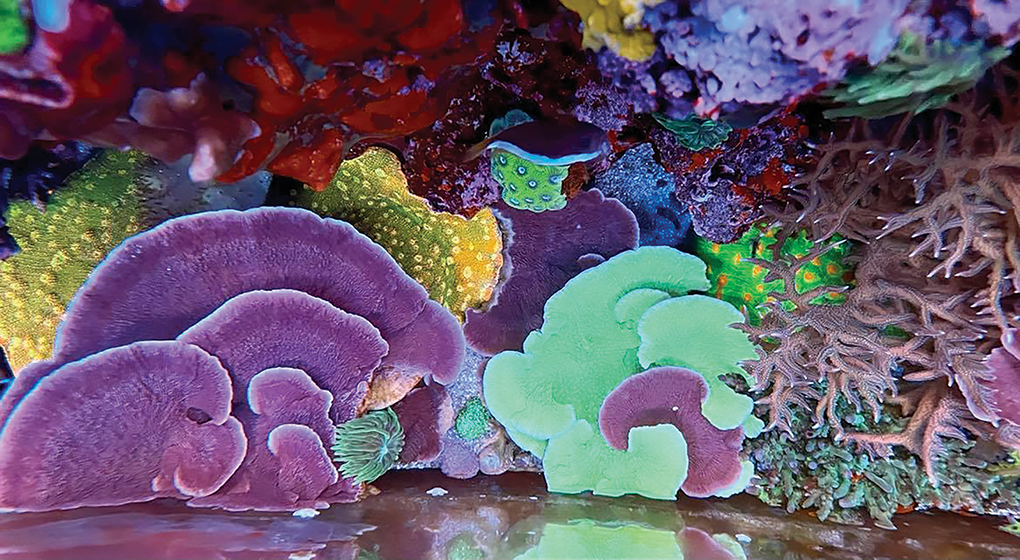
But Marc says that it was high nitrate levels that truly demanded attention. “For the last few years, my nitrates have been around 80 ppm. Nitrate was my Kryptonite. (I keep my phosphates low at about .5 ppm by using lanthanum chloride—Blue Life’s Phosphate Rx—every 6 or 8 weeks.) Everything that had adjusted to the nitrates kept growing, but I couldn’t add anything new; it would just die in three days. Duane was here for a week, but we talked about a plan for several days before we attacked the tank.
“The tank is vastly different now. This time around, Duane was terrified by what we had done. This tank had been featured on YouTube every week, and now it looked empty. But there were spots in the tank where I hadn’t been able to get at the sandbed [to clean it] for eight years.”
“Now, my nitrates are about 30 ppm. I think that’s why the colors on the coral are starting to improve. That, and I finally changed out my metal halides for the new Neptune SKY LEDs. My ‘Shadowcaster’ Acropora [so named because it grew so large it cast shadows on other corals, starving them of light] just sat there under metal halides, but now I have these new polyps popping up all over the coral!”
A LITTLE HELP FROM MY FRIENDS
For every challenge Marc has hurdled, and every big task he has taken on, one of the biggest undercurrents of support is from reefkeeping friends. It takes 10 people to move a 400-gallon glass aquarium into a home, another 10 to move it back out, and then another 10 to move in the replacement. Marc joked, “I’d like to ask you to dedicate this Aquarium Portrait to all the friends that I lost, the ones that would never come back to help me move another leaking aquarium, the ones that flat-out refuse to lift a heavy tank more than once in their lives. By the way, I’m looking for some new friends, just in case.”
All who know Marc Levenson are aware that his is a story of resilience, optimism, community, humor, and humility. He is an aquarist who admits his mistakes so that others can learn from them. His followers will also suspect that this is far from the final chapter on Melev’s reefs—which seem to follow the Vulcan logic of Mr. Spock: “Change is the essential process of all existence.”
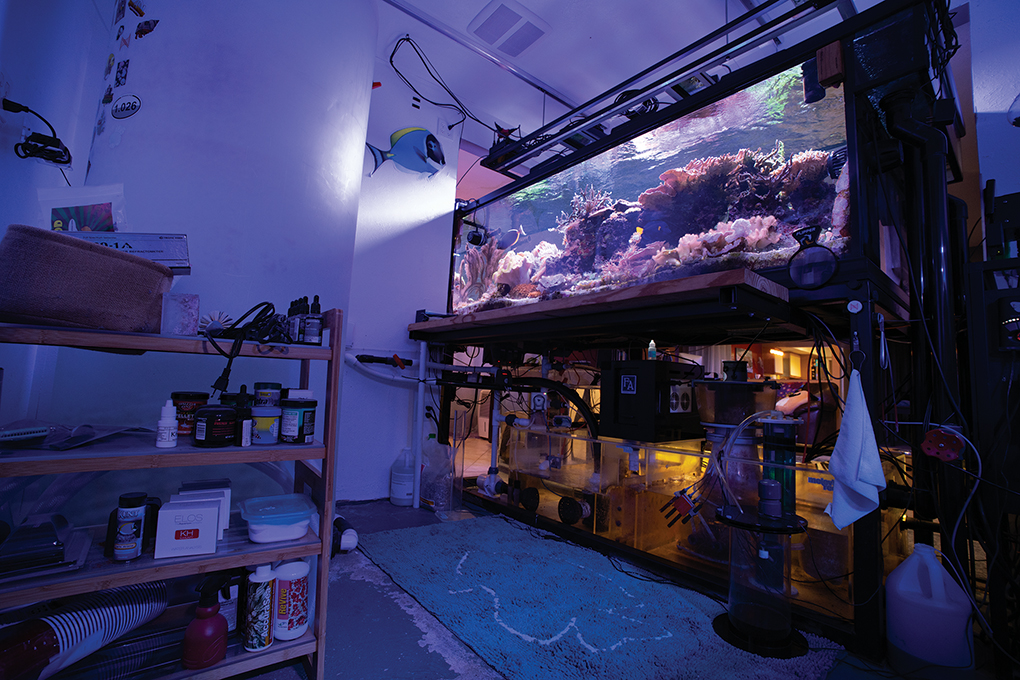
AQUARIUM Details
TANK SIZE AND TIME IN OPERATION:
MAIN AQUARIUM: Marineland custom-built 400-gallon (1,514-L) 84 x 36 x 30 inches (LxWxH) (213 x 91 x 76 cm) 0.75-inch (19 mm) glass tank; Starphire glass on all three viewing panels. External hanging overflow box, hidden behind a ¼ in. sheet of black acrylic.
- Doubled Euro bracing around the top; inner Euro bracing around base for added strength. 1-inch (2.5-cm) thick bottom glass pane.
- Custom sump under tank, made by Marc: 136 gallons (518 L) Includes 20-gallon (75-L) refugium zone.

SATELLITE “ANEMONE CUBE”: AGE 60 gallons (227 L) 24 x 24 x 24 inches (LxWxH) (61 x 61 x 61 cm); Starphire glass on three sides, internal corner overflow box. Anemone cube drains into the 400-gallon’s sump.
TOTAL SYSTEM VOLUME: 597 gallons (2,260 L).
ACTUAL WATER VOLUME: 450 gallons (1,703 L) of saltwater.
TIME IN OPERATION: System started November, 2013, and has been operational for nearly 8 years. Images taken in spring/summer of 2021.
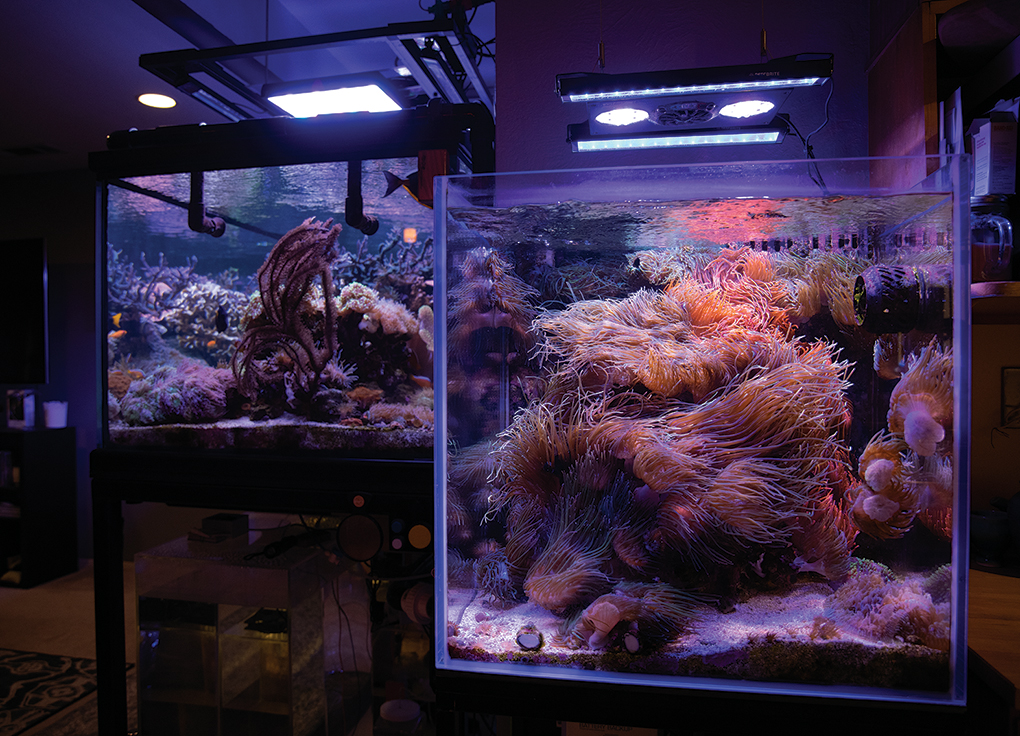
AQUASCAPING / SUBSTRATES:
- 4-inch (10-cm) deep sand bed (600 lbs / 272 kg) of Tropic Eden’s Reef Flakes sand
- Approximately 300–350 lbs. (136–159 kg) of live rock accumulated over a 10-year period from Marc’s prior reef aquariums. No base rock or dry rock used.
LIVESTOCK:
- 1 x Naso Tang (“Spock”), Naso literatus
- 1 x Purple Tang (“Crown Royal”), Zebrasoma xanthurum
- 1 x Yellow Tang (“Frick”), Zebrasoma flavescens
- 1 x White-tailed Kole Tang, Ctenochaetus flavicauda
- 5 x Pajama Cardinalfish, Sphaeramia nematoptera
- 11 x Tangerine Skunk Clownfish (captive-bred), Amphiprion sandaracinos
- 1 x Copperband Butterflyfish, Chelmon rostratus
- 1 x Cleaner Wrasse, Labroides dimidiatus
- 3 x Lyretail Anthias (1 male, 2 female), Pseudanthias squamipinnis
- 1 x Coral Beauty (newest addition), Centropyge bispinosa
- 12 x Ocellaris Clownfish (captive-bred; in anemone cube), Amphiprion ocellaris
- 3 x (3) Banggai Cardinalfish (in Anemone Cube), Pterapogon kauderni
- 2 x (2) Randall’s Shrimp Gobies (in anemone cube), Amblyeleotris randalli

CORALS AND OTHER CNIDARIANS:
- 25 x Acropora spp. including A. milleopora
- 12 x Fungia sp.
- 8 x Montipora spp.
- 8 x types of chalice corals from various genera
- 5 x types of Acanthastrea sp. including A. echinata
- 1 x Branching Cyphastrea sp.
- 4 x types of Birdsnest, Seriatopora spp.
- 3 x Pavona spp., plating and scrolling
- 1 x Tyree Green Polyp Toadstool, Sarcophyton sp.
- Various other corals, including Anacropora, Euphyllia spp. (hammer, frogspawn), Diploastrea, Herpolitha limax, Turbinaria, Lobophyllia, Duncanopsammia, Leptastrea, Dendrophyllia, Platygyra pini, gorgonians, many zoanthids, Palythoa, and other stony and soft corals.
INVERTEBRATES:
- 1 x Red Serpent Starfish
- 2 x Brown Serpent Starfish
- Various Tigertail Sea Cucumbers, Trochus Snails, Super Tongan Nassarius snails, Blue-legged Hermit Crabs
- Sebae Anemone (Heteractis malu)
- Bubble Tip Anemones, various cultivars (Entacmaea quadricolor, in the Anemone Cube)
WATER CIRCULATION:
- (2) Ecotech Marine Vortech MP60wQD circulation pumps
- (1) Ecotech Marine Vortech MP40wQD circulation pump (on the Anenome Cube)
- (2) Vivid Creative Aquatics Random Flow Generator nozzles on return assembly
- (1) Abyzz A200 return pump Ecotech Marine Vectra L1 manifold pump
- (4) 12-volt batteries in parallel, to run all Ecotech pumps on the systems in event of a power failure, estimated to run for 32 hours, added August, 2021.
COOLING:
- (3) 120mm IceCap cooling fans blow down on water in sump when needed.
- Average room temp.: 73° F/22.8° C
LIGHTING:
- (3) Neptune Systems SKY LED modules
- (2) Reef Brite XHO LED actinic 6-foot-long strips
- 11:30 a.m. to 11:30 p.m. schedule, with 8 hours, “high noon” intensity

FEEDING:
Frozen foods offered nightly: PE Mysis, Rod’s Food Original Blend, IQF Pro Salt Krill, Hikari Mini Mysis. 2–3 times per week dried nori sheet clipped to the glass magnetically
Monthly treat: a 1-inch (2.5 cm)pinch of fresh banana
WATER PARAMETERS:
Alkalinity: 9.5 dKH
Calcium: 420 ppm
Magnesium: 1,450 ppm
Salinity: 35 ppt
Temperature range: 77.6–78.9° F (25.3–26° C)
Nitrate: < 40 ppm
Phosphate: 0.5 ppm
MAINTENANCE REGIME:
Cleaning the glass is the number one task and is often performed 3–4 times a week. The protein skimmer’s collection cup is cleaned every two weeks. Water changes using Aquavitro Salinity are sporadically performed. Water tests are performed weekly using Elos test kits. All Vortech wet sides are cleaned every 3 months, and any detritus found in the sump is removed. All pumps, the entire skimmer, and the reactors receive an annual deep clean. Substrate in the tank and refugium is siphoned approximately once a year. ICP testing is performed annually.
OWNER:
Marc Levenson, Fort Worth, Texas

Necessities
Levenson says, “I consider these system features and ancillary equipment essential for my success with this reef aquarium:”
- A 250-gallon (946-L) poly tank, situated behind the aquarium, is used for mixing and storing saltwater for water changes. The system utilizes a Vectra M2 circulation pump.
- A 43-gallon (162-L) top-off reservoir (under tank), next to sump, made by Marc.
- Neptune Systems APEX controller with Trident water monitoring, remote access via APEX Fusion with notifications
- A custom-made steel stand with removable walkboard, made with 2″ square tubing ¼” thick and powder-coated. The very sturdy walkboard makes accessing and working on the aquarium significantly easier and can be placed on either side of the aquarium. It can support two people at once.
- All lighting is mounted on a rolling light rack, so it can be easily moved out of the way when full access is needed above the tank. Levenson appreciates the full access to the aquarium from all angles, and the industrial look.
- The fish room behind the aquarium is outfitted with a French drain for spills and smaller water changes.
- The room utilizes a vent fan that runs 24 hours a day.
- Levenson maintains a stand-alone 60-gallon frag system.
- The Avast Marine skimmer Swabbie on the protein skimmer’s collection cup reduces skimmer maintenance and improves skimmer performance.
- The protein skimmer waste collector shuts off skimmer when full and sends a notification through APEX Fusion.
- CarbonDoser Electronic CO2 Regulator to regulate flow from CO2 tank (which feeds into the calcium reactor)
- Push-button controls to quickly activate APEX programming (feeding, 10 mins more light, 45-min water change period)
- Modular (removable) sock box holds one 7-inch (18-cm)sock, used for deep cleaning or during lanthanum treatments.
- “My tank-sitter, Bobby Wade, who has kept watch over my aquariums anytime I’ve traveled over the past 10 years. Everyone needs a Bobby!,” Marc exclaimed!
ONLINE
Melev’s Reef: https://www.youtube.com/melevsreef
melevsreef.com
Get More!
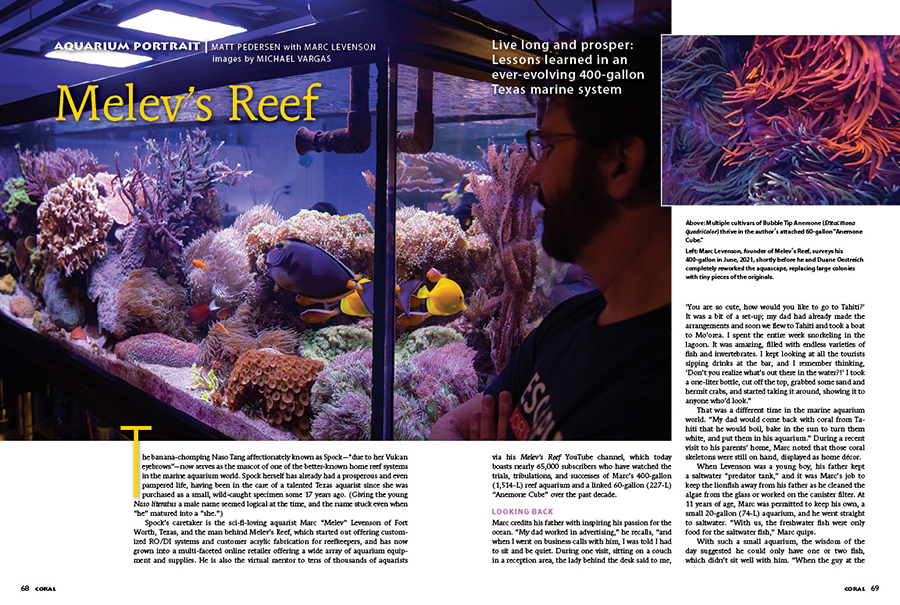
Subscribe to CORAL Magazine to get our flagship print edition delivered to your door six times per year! Subscribers also have access to a digital archive of CORAL issues going back several years!






Awesome!